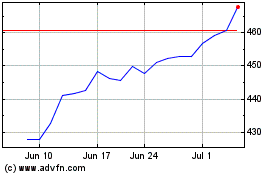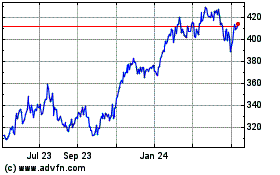Windows 10 Adoption Grows as Microsoft Promotes Operating System
June 29 2016 - 8:29AM
Dow Jones News
By Jay Greene
More than 350 million devices now run Windows 10, as Microsoft
Corp.'s campaign to promote the latest version of its flagship
operating system builds steam.
Windows 10 adoption has risen alongside aggressive practices on
the part of Microsoft, intended to spur upgrades from earlier
versions, that have riled some consumers. Microsoft promised to
soften that approach on Monday.
The company is racing to meet a goal of 1 billion Windows
devices in use by the end of June 2018. Windows 10 adoption has
grown 16.7% since early May, when the company said that 300 million
devices were running the software. Microsoft would need to post an
average compounded quarterly growth rate of roughly 19% to achieve
its goal.
Windows 10, which made its debut last summer, represents a
strategic bet for the company. The software runs on not only
personal computers, but also on phones, tablets and the Xbox gaming
console.
Microsoft is trying to leverage Windows' dominance in
personal-computer operating systems to help it gain ground in
mobile devices, where operating systems from Alphabet Inc.'s Google
and Apple Inc. dominate. The more people who use Windows 10, the
company reckons, the better its chance of convincing developers to
create Windows versions of sought-after applications for mobile
devices.
The "vast majority" of devices running Windows 10 are desktops
and laptops, said Lisa Gurry, senior director for Windows at
Microsoft.
Researchers at Gartner Inc. have said corporate customers aren't
likely to roll out the operating system broadly until 2017. Ms.
Gurry said 96% of Microsoft's corporate customers are testing the
software, though she declined to disclose the number of those
accounts.
Microsoft's effort to spur Windows users to upgrade to Windows
10 led to complaints the company was being overly aggressive.
Customers using earlier versions received pop-up alerts offering a
free upgrade. When they clicked a red "X" in the top right corner
of the alert box, which typically dismisses an alert, an upgrade
was initiated.
Microsoft dialed back that approach Monday. Now, when the alert
appears, customers will have the option to upgrade immediately,
choose a time to upgrade or decline to upgrade. And clicking the
red "X" will dismiss the dialog box, though the company will remind
customers of the upgrade option a few days later.
The company also said Monday that a new version of the operating
system, Windows 10 anniversary update, would make its debut Aug. 2.
Microsoft announced the update at its conference for software
developers in March, but it didn't disclose a release date at the
time. The update will include new security features and a feature
called Windows Ink that lets users scribble sticky notes or
annotate documents with a digital stylus.
The update will also enable Cortana, Microsoft's
voice-controlled assistant software, to work directly from
device-lock screens, so users won't have to log into their devices
to access the app. And the new version of Windows will include Xbox
Play Anywhere, a function that lets users start videogames on an
Xbox One console and continue it on a Windows 10 personal computer
or mobile device, if the game supports the capability.
The anniversary update will be free on devices that already run
Windows 10. Microsoft has offered free upgrades to Windows 10 for
devices running Windows 7 or Windows 8 until July 29. The
anniversary update will cost $119 for customers who want to upgrade
devices that aren't already running Windows 10.
Write to Jay Greene at Jay.Greene@wsj.com
(END) Dow Jones Newswires
June 29, 2016 08:14 ET (12:14 GMT)
Copyright (c) 2016 Dow Jones & Company, Inc.
Microsoft (NASDAQ:MSFT)
Historical Stock Chart
From Mar 2024 to Apr 2024

Microsoft (NASDAQ:MSFT)
Historical Stock Chart
From Apr 2023 to Apr 2024
